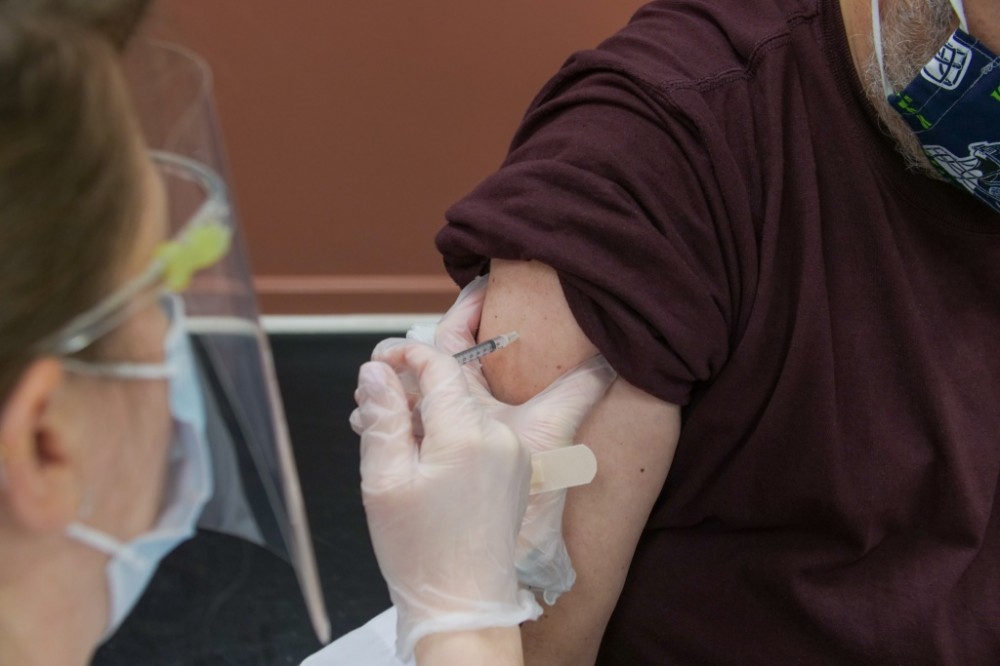When it comes to the COVID-19 vaccine, arm pain pays to protect. But that doesn’t necessarily make your shoulder hurt less.
According to a February this year, after receiving the Pfizer-BionTech vaccine, up to 75 percent of people experience pain at the injection site. After the second dose, 27 percent have some swelling. And even if you’ve had some shoulder pain after the shot, arm discomfort tends to be greater after the COVID-19 shot than after the flu shot, according to the article.
Luckily, you can easily mitigate the side effect, without pain relievers like ibuprofen or acetaminophen. All you have to do is some gentle exercises for your arms.
Begin exercises before muscle pain develops in order to minimize this side effect. Many vaccination sites require you to sit in an observation area for 15 to 30 minutes to monitor yourself after receiving the dose. Feel free to start some of these exercises while you’re there.
From there, continue doing 5 to 10 repetitions of each movement approximately every hour for one and four days, or until the pain subsides. You can do them with just the arm that received the injection or with both arms.
Why does my arm hurt after an injection?
Some pain in the arm after vaccination is totally normal. It is part of your body’s natural response to piercing the deltoid with a needle, as well as to the chemicals inside the syringe.
Post-vaccination discomfort is a sign that your body is building protection against the new coronavirus. Inflammation is a normal part of your immune system’s response to building a defense. The immune system activates chemicals to help respond to the vaccine, which can cause localized swelling and pain at the injection site.
However, if you don’t have pain in your arm after the shot, it doesn’t mean it didn’t work.
Why does the COVID-19 vaccine cause more arm pain than the flu vaccine?
Both the Pfizer-BioNTech and Moderna vaccines are Messenger RNA (or mRNA) vaccines. These work by depositing a weakened or inactive virus in the body. Instead, mRNA vaccines teach our cells how to make a protein (or a portion of a protein) that will fight infection if we are exposed to the virus in the future.
There does not appear to be a clear explanation for why COVID vaccine recipients experience more pain than routine vaccines, but it could possibly be because mRNA vaccines have preservatives and stabilizers that are unique to them.
Also, this may be a bit speculative, but COVID-19 is really novel and most of the human population has not been exposed to any of them. So it could be argued that our immune system is completely naive about this virus and its antigens.

Why Does Gentle Exercise Relieve Arm Pain?
To date, no research has investigated why movement might limit the degree of vaccine-induced muscle tenderness. But there are a number of theories as to how light exercise can minimize pain after intense exercise. And they probably apply to arm pain after the COVID vaccine. After all, both are signs of micro-trauma within the shoulder muscle.
- Blood flow is increased. The microscopic injury to the deltoid results in metabolic by-products that can stimulate discomfort, but moving the pain into the muscles increases blood flow to the area, helping to flush chemicals from your body and ease arm aches.
- Get s endorphins. High exercise is real. Endorphins released during exercise can temporarily reduce the interpretation and experience of pain in the brain.
- It has anti-inflammatory effects . Active muscle contractions that occur with movement of light can potentially scatter localized edema or swelling to some extent.
The best exercises for arm pain after getting vaccinated
Shoulder circle
- Extend your arms out to the sides at shoulder height, palms facing forward.
- Slowly rotate your arms in small backward circles.
- Do all the reps, then repeat with forward circles.
Shoulder press
- Extend your arms out to the sides at shoulder height, palms facing forward. Bend your elbows to form a “goal post” position with your arms.
- Slowly press your arms toward the ceiling until your elbows are straight.
- Pause, then slowly lower your arms toward the “goal post” position.
Side aerial sweep
- Let your arms hang at your sides with your palms facing forward.
- Keeping your elbows straight, slowly slide your arms out to the sides and then over your head.
- Pause, then slowly lower your arms to your sides.
Top-forward sweep
- Let your arms hang at your sides with your palms facing your body.
- Keeping your elbows straight, slowly move your arms forward and then overhead.
- Pause, then slowly lower your arms to your sides.
Arms opening and closing
- Extend your arms out to the sides at shoulder height, palms down.
- Bring your arms forward until your thumbs almost meet.
- Pause, then bring your shoulder blades together to extend your arms to your sides.
Walk on the wall
- Stand one foot away from a wall. Place the palm of your hand against it at shoulder height, with the elbow bent.
- Slowly slide or “walk” your hand up the wall until your arm is fully extended.
- Pause, then slowly reverse the movement to bring your hand to shoulder level.
- Repeat on the other side, if desired.